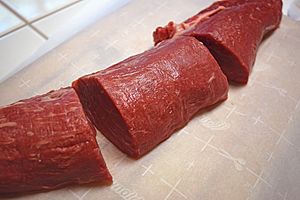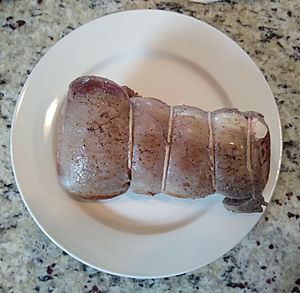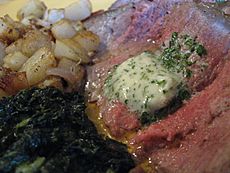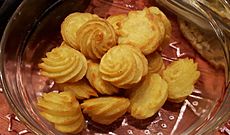Chateaubriand (dish) facts for kids
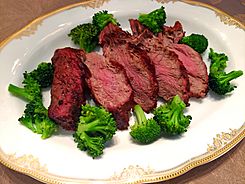
Chateaubriand roast from the front cut of a beef tenderloin
|
|
| Type | Tenderloin cut of beef |
|---|---|
| Place of origin | France |
| Created by | Chef Montmireil named this dish after Vicomte François-René de Chateaubriand |
| Serving temperature | Hot (45 to 50 °C (113 to 122 °F)) for rare meat served either on a hot plank or on a platter |
| Main ingredients | Tenderloin front cut |
| Variations | Planked Chateaubriand Chateaubriand Bouquetiere Chateaubriand with Duchesse Potatoes Chateaubriand sauce Béarnaise Chateaubriand sauce Colbert Chateaubriand Maitre d'Hôtel Liée |
Chateaubriand (sometimes called chateaubriand steak) is a fancy French dish. It's usually a thick, juicy cut of beef tenderloin. Originally, it was cooked in a special way. This involved grilling it between two smaller pieces of meat that were thrown away later. But over time, the name "Chateaubriand" started to mean the specific cut of beef itself. This change happened thanks to a famous chef named Auguste Escoffier.
In the 1800s, this steak could also come from the sirloin part of the cow. It was often served with a special sauce called Chateaubriand sauce. This sauce was made with ingredients like white wine, shallots, and herbs. Mushrooms were also a common side dish served with it.
Contents
How Chateaubriand Got Its Name
It's common for dishes to be named after people. For example, the sandwich was named after John Montagu, 4th Earl of Sandwich. Another example is carpaccio, named after the Italian painter Vittore Carpaccio. The dish Chateaubriand was named after the French author François-René de Chateaubriand. Interestingly, "Chateaubriand" still keeps its capital letter, unlike "sandwich" or "carpaccio."
There are different stories about how this dish first came to be. Many famous dishes are invented by skilled chefs. The French food guide Larousse Gastronomique says that the dish Chateaubriand was created by Montmireil. He was the personal chef for Vicomte François-René de Chateaubriand. This happened in 1822 when the Vicomte was the Ambassador of France in England. Montmireil also created a dessert first called pudding a la Chateaubriand. It is now known simply as pudding diplomate.
The name "Châteaubriant" is also an alternative spelling of the Vicomte's last name. The Dictionnaire de l'Académie des Gastronomes suggests it comes from the town of Châteaubriant in Loire-Atlantique, France. This town is famous for breeding beef cattle.
Originally, the term "Chateaubriand" described the way the meat was prepared. However, by the 1870s, when it came to England, the name started to refer to the steak or cut of meat itself. What was once called filet de bœuf became known as Chateaubriand. Chef Montmireil first cooked the Chateaubriand by roasting it between two smaller pieces of meat. This special technique made the steak taste better and kept it very juicy.
Famous Ways to Prepare Chateaubriand
Delmonico's Restaurant Method
Delmonico's Restaurant in New York opened in 1827 as a pastry shop. It quickly grew into a full French restaurant by 1830. It was considered as good as the best restaurants in France. Louis Napoleon visited New York in 1837 and often ate there. One of the first items on their menu was "Beef tenderloin with sauce."
In 1893, Charles Ranhofer, a former chef at Delmonico's, described the exact cut of meat for his Chateaubriand. He said it was the center part of the beef tenderloin. Ranhofer explained that this center loin was given the name Chateaubriand. In his 1893 recipe, a 20-ounce (about 567 grams) tenderloin center was flattened to about 3 centimeters (1.2 inches) thick. It was then broiled over a slow, steady fire. It took 16 minutes for very rare, 18 minutes for properly done, and 20 minutes for well done. The cooked steak was served with maître d'hôtel butter or gravy.
Escoffier's View
French chef Georges Auguste Escoffier gave names to different steak cuts. He called Tournedos the small, round pieces cut from the fillet. Escoffier explained:
Chateaubriands are taken from the middle of the trimmed beef fillet. They are cut two or three times thicker than a regular fillet steak. However, if it's going to be grilled, a Chateaubriand shouldn't be more than 500 grams (about 1 pound 2 ounces). If it's larger, the outside can become too dry before the inside is cooked properly. Today, Chateaubriands are served with any sauces and sides that work well for Tournedos and fillet steaks.
While Escoffier named the cut of meat, he only mentioned Vicomte François-René de Chateaubriand as the creator of the sauce named after him. However, the Auguste Escoffier School of the Culinary Arts says:
Chateaubriand is actually a recipe. It's usually grilled or broiled and served with Béarnaise sauce and chateau potatoes. These potatoes are shaped like olives and cooked in butter. It's usually cut from the center of the tenderloin and is big enough for two people.
Cooking on a Plank
In 1917, an article in Good Housekeeping magazine talked about cooking Chateaubriand on a plank. The author, Katherine Campion, wrote: "Until very recently, a Beefsteak Chateaubriand was always cooked and served on an oaken plank. But now, broiling the steak and serving it from a silver platter has replaced the plank." The article gave credit to Vicomte François-René de Chateaubriand for starting this cooking method. He used it for his meats and game, which were served with rich sauces and garnishes.
Oak planks add a lot of flavor to the meat. They were useful for both hotels and home cooking. Planks were sold plain or with silver stands for a nice presentation. Some well-made planks had carved grooves to collect the meat juices. The author suggested using thickly cut tenderloin, porterhouse, or rump steak. The meat was skewered into shape and broiled on one side. While the meat broiled, the plank was heated in a hot oven until it started smoking.
Once ready, the plank was removed from the oven and buttered. After the meat cooked for 5 to 7 minutes, it was taken from the broiler and placed onto the plank, cooked side down. Mashed potatoes were then piped around the meat in a wavy border or other designs. Stuffed bell peppers or tomatoes were arranged, one per person, pressed into the potato border. Cooked mushrooms were added on top. The entire plank was then put back into a hot oven. It stayed there until the meat was cooked to liking, the potatoes were lightly browned, and the vegetables were tender. Finally, the meat was seasoned with salt, pepper, and paprika, with a little butter rubbed on top. A garnish of watercress was added.
Modern Ways to Prepare Chateaubriand
By the 1950s in the United States, Chateaubriand became a special meal for important guests in Las Vegas, Nevada. It became a common dish in the fancy supper clubs there, known as gourmet rooms. These were found both on and off the Las Vegas Strip. According to Woman's Day magazine in 1966, "A Chateaubriand steak in most modern restaurants is a thick slice of tenderloin. It's covered with beef fat or bacon and broiled to the desired doneness (à point, as the French say). Then it's served with Chateaubriand Sauce."
In the 1985 book Contemporary Cooking by James Charlton, the dish "Chateaubriand with Duchesse Potatoes" is described. The steak is broiled until almost done. Then, the nearly cooked steaks are placed onto a plank. Mushrooms, tomatoes, and piped duchess potatoes are arranged around the meat and vegetables. The plank is then put back into the broiler for the steak to finish cooking and the potatoes to lightly brown.
What to Serve with Chateaubriand
- Maître d'hôtel butter
- Chateaubriand potatoes, also called chateau potatoes or pommes de terre château. These are potatoes cut into a tournée shape (about 5 centimeters or 2 inches long) and sautéed in butter.
- Bouquetière or à la bouquetière is a way of arranging vegetables around a roast to look like flowers. Carrots, turnips, and potatoes browned in butter are often used. Cauliflower in Hollandaise sauce is also common. Glazed olive-shaped vegetables with a sherry-flavored jus Lié (lightly thickened juice) on the side can also be included.
Sauces for Chateaubriand
- Chateaubriand sauce (sometimes called "crapaudine sauce") is a cooking sauce often served with red meat. It's made by reducing (cooking down) liquids. It usually goes with Chateaubriand steak. Other dishes, like tournedos villaret, also use this sauce. The exact origin of this sauce is debated. Some say chef Montmireil created it. Others think it started at the Champeaux restaurant after de Chateaubriand's book, Itinéraire de Paris à Jérusalem, was published.
The sauce is made with shallots, mushrooms, thyme, bay leaf, tarragon, white wine, brown veal stock, and beurre maître d'hôtel (sweet butter with parsley). Other ingredients can include meat glaze, demi-glace, pan drippings, onion, lemon juice, cayenne pepper, peppercorn, and salt. To make it, all ingredients except the brown veal stock and beurre maître d'hôtel are cooked together. They are cooked until the mixture is reduced by two-thirds. After this, veal stock is added in the same amount as the wine used before reduction. This mixture is then reduced by half. The last step is to strain the mixture. Then, chopped tarragon and beurre maître d'hôtel are added on top. The sauce is commonly served with Chateaubriand steak and potatoes.
- Béarnaise sauce is often served with Chateaubriand. Châteaubriand sauce béarnaise is a double fillet steak with béarnaise sauce. It is served with pommes fondantes.
- Colbert sauce
|
See also
 In Spanish: Filete chateaubriand para niños
In Spanish: Filete chateaubriand para niños



